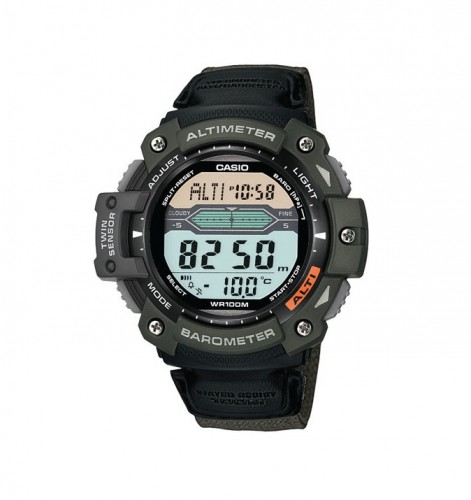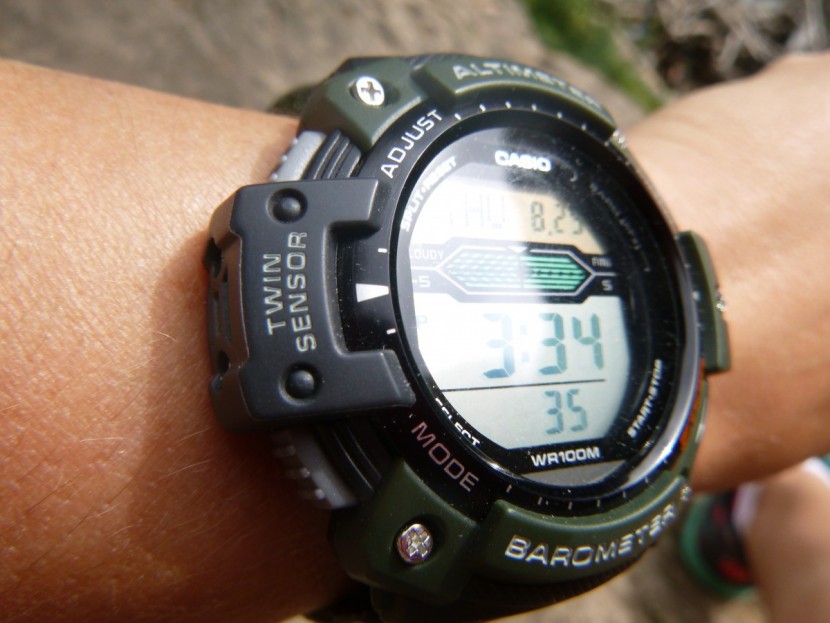Casio SGW300HB Review
Our Verdict
Our Analysis and Test Results
The SGW300HB is simple, inexpensive, and easy to use. It provides decent accuracy and does well in most climates. This is a solid, affordable option for the outdoor enthusiast on a shoestring budget. This model has very good battery life and is easy to use. It scores poorly because of its limited features, simultaneously basic and busy display, and unattractive aesthetic.
Altimeter Accuracy
The SGW300HB scores low in this metric, but don't let that be too deceiving. Most of the time it was off by a respectable 50 to 200 feet when properly calibrated.
In fact, we noticed that its accuracy is similar to its sibling, the Casio PRW-6000Y. Some of the reasons for its lower score include its precision and susceptibility to inaccuracy due to changes in barometric pressure. Pricier altimeter watches will have an altitude increment of 1 meter (3 to 5ft). This watch just isn't that sensitive, offering a 5 meter (20ft) interval.
Battery Life
This watch runs on a simple, traditional watch battery. It is estimated to last up to three years, making it a great option for long excursions into the backcountry.
If you need to change the battery, unscrew the backplate and insert a new one, ready to go for another few years. As a result, this watch scores highly in the battery life metric. The solar-powered Casio PAG240B-2 and the Casio PRW-6000Y are the only options that will last longer without any additional maintenance.
User Experience
Because of its simple features, it's one of the fastest models to get to know. The buttons are well marked and the essential functions are super simple to figure out. More complex features like determining altitude differential require a little finagling and consulting the user's manual.
Even though we liked its ease of use, it's not ideal for winter wear. The recessed buttons are tough to press while wearing a pair of gloves. If this is an essential feature to you, check out the Suunto Ambit3 Peak or the Suunto Core Alu. Both have much larger, protruding buttons and easy-to use-interfaces.
We are not super impressed with the display quality. The font and watch face are small, and the glass seems less durable. It can also be very difficult to read in direct sunlight.
Also, the backlight has only one to three-second display options (similar to the Casio PRW-6000Y). It is also dim, providing an orange light that is not super sharp in the darkness. Though its functions are simple, Casio also managed to cram a ton of words and symbols both on and around the watch face. We feel that it's just a little too busy given what the product is actually capable of doing.
Features
This dual-sensor watch is truly the best if you're looking for something inexpensive and simple. It features an altimeter-barometer, temperature sensor, and a timekeeper. That's about it. There is no compass, and of course, no GPS.
Altimeter and Barometer
The altimeter-barometer allows you to view barometric pressure (in hPa or inHg) and altitude (meters or feet) at your current location. It (mostly) can't graph data that it records, but it does allow you to determine a barometer or altitude differential between two areas. In comparison to all the watches tested, it has the most limited features.
The exception to the data graphing is that when the watch is taking a barometric pressure reading, the horizontal arrows at the top (which count off seconds in timekeeper mode) will indicate whether the pressure is rising or falling. Combined with the words cloudy and fine it provides a basic indication of whether conditions are improving or deteriorating.
Timekeeping
This digital timekeeper has a few basic features. World time (with 31 time zones), a stopwatch, countdown timer, and five daily alarms. The time is easy to set manually and also has a daylight savings time setting. You can choose between a 12hr or 24hr display. The one feature that makes the SGW300HB stand apart from the rest is the ability to set five different alarms (something found only in other Casio models).
Comfort and Fit
Because of its small display and light weight, this watch is fairly comfortable relative to many of the other chunkier models. It is easy to wear underneath a jacket or long sleeved shirt and doesn't dig into your wrist.
The major strike against it in this metric is the woven nylon strap. It is stiff and rubs against the wrist, irritating the skin after a while. The holes in the strap seem hastily punched and are itchy, while the strap itself lacks breathability. Even though it fits well under clothes, we didn't like that it couldn't be put on top of a jacket layer — the strap was just too short.
Value
Even though this watch scored fairly low in many of the comparative metrics, we still think it offers great value. It is the least expensive model by a long shot. The accuracy of the watch is decent and if the intervals weren't so large, it would be comparable to its $600 Casio sibling. It's also the best option for those on a tighter budget.
Conclusion
If you need an altimeter watch, but can't spend hundreds of dollars, or are just looking for a regular watch and would also enjoy being able to register altitude now and then, this is your best bet.













